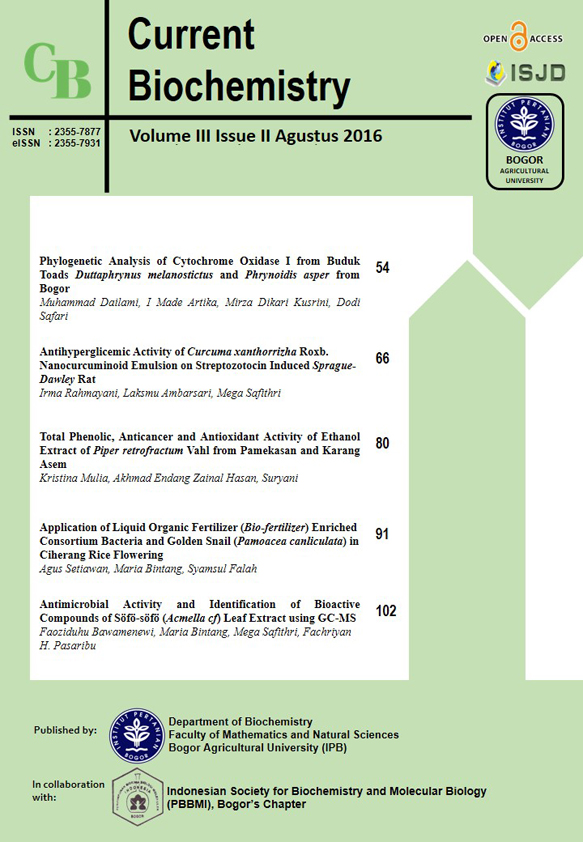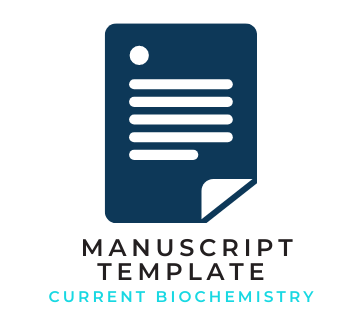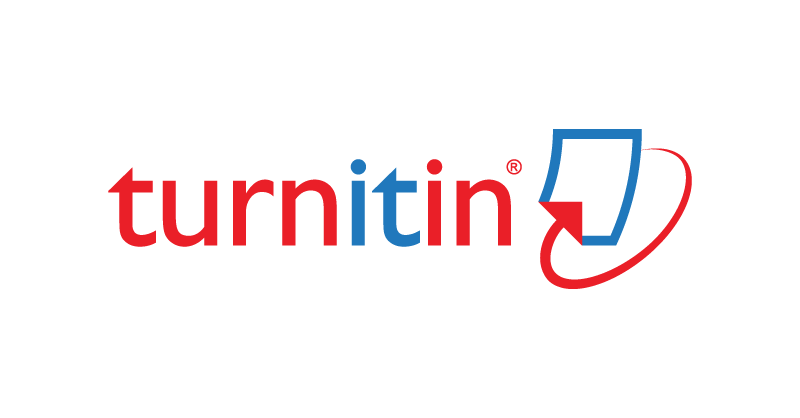Antihyperglicemic Activity of <i>Curcuma Xanthorrizha</i> Roxb. Nanocurcuminoid Emulsion on Streptozotocin Induced <i>Sprague-Dawley</i> Rat
Abstract
Curcuminoid, a natural compound isolated from Curcuma xanthorrhiza RoxB (Temulawak) has been reported to possess antioxidant, anti-inflammatory, anticancer, antimicrobial and anti-hyperglicemic properties. The curcuminoid is weakly soluble in water that restricts its bioavailability. This problem could be overcome by incorporating curcuminoid into solid lipid nanoparticles (SLN). Nanocurcuminoid was prepare by using homogenization-ultra sonication methods. Nanocurcuminoid obtained in this study was 523.5 nm in size and polydispersity index of 0.218 with entrapment efficiency of 24.2 %. Rats were made diabetic by induction of 50 mg / kg BW STZ, treated with the chosen formula (doses 5, 10, 20 mg/kg BW) orally for 15 days. Body weight and blood glucose levels were measured from day 0, 4th,7th,11th and 15th. The results showed that 15 days of daily treatment of 10 mg/kg BW nanocurcuminoid emulsion led to a reduction of blood glucose level by 30.93±14.90 % and body weight by 15.5±13.92 %. Curcuminoid formulated in solid lipid nanoparticles could suppress a decrease in body weight and lower blood glucose levels of rats.
References
Ambarsari L, Nurcholis W, Darusman LK, Mujib MA, Heryanto R. 2014. The curcuminoids extract of curcuma xanthorriza roxb loaded solid lipid nanoparticles. IJSR. 3:852-858.
Anand P, Kunnumakkara AB, Newman RA, Aggarwal BB. 2007. Bioavailability of curcumin: Problems and Promises. Molecular Pharmaceutics 4:807-818.
Anton N, Benoit JP, Saulnier P. 2008. Design and production of nanoparticles formulated from nano-emulsion templates – A Review. J Control Release. 128: 185–199.
Basnet P, Natasa SB. 2011. Curcumin: An anti-inflammatory molecule from a curry spiceon the path to cancer treatment. Molecules. 16: 4567-4598.
Bastaki. 2005. Review diabetes mellitus and its treatment. Int J Diabetes & Metabolism. 13:111-134.
Dutta KA, Ikiki E. 2013. Novel drug delivery systems to improve bioavailability of curcumin. J Bioequiv Availa 6:1.
Ekaputra, HR. 2013. Optimisasi dan karakterisasi nanokurkuminoid tersalut asam palmitat [Skripsi]. Bogor (ID): Institut Pertanian Bogor.
Eleazu CO, Eleazu KC, Chukwuma S, Essien UN. 2013. Review of the mechanism of cell death resulting from streptozotocin challenge in experimental animals, its practical use and potential risk to humans. J Diabetes Metab Disord. 12:60.
Elsner M, Guldbakke B, Tiedge M, Munday R, Lenzen S. 2007. Relative importance of transport and alkylation for pancreatic beta-cell toxicity of streptozotocin. Diabetolgia. 43:1528–1533.
Ghalandarlaki N, Alizadeh AM, Ashkani-Esfahani S. 2014. Nanotechnology-applied curcumin for different diseases therapy. BioMed Research International. 1-23.
Howard M. 2011. Evaluation of The Physicochemical Properties and Stability of Solid Lipid Nanoparticles Designed for The Delivery of Dexamethasone to Tumors [disertasi]. Lexington (US): The Graduate School University of Kentucky.
Hussain. 2002. Hypoglycemic, hypolipidemic and antioxidant properties of combination of curcumin from curcuma longa, linn, and partially purified product from abroma augusta, linn. in streptozotocin induced diabetes. Indian J Clin Biochem. 17(2):33-43.
[IDF] International Diabetes Federation. 2013. Diabetes Atlas Sixth Edition [internet]. [diunduh 2014 Ags 12]. Tersedia pada: www.idf.org/diabetesatlas.
Jayaprakasha GK, Rao LJ, Sakariah KK. 2002. Improved HPLC method for determination of curcumin, demethoxycurcumin, and bisdemothoxycurcumin. Food Chemistry. 50:3668-3672.
Kakkar V, Singh S, Singla D, Kaur IP. 2011. Exploring solid lipid nanoparticles to enhance the oral bioavailability od curcumin. Mol. Nutr. Food Res. 55:495–503.
Kim M, Kim C, Song Y, Hwang J. 2014. Antihyperglycemic and anti-Inflammatory effects of standardized curcuma xanthorrhiza roxb. Extract and its active compound xanthorrhizol in high-fat diet-induced obese mice. Evidence-Based Complementary and Alternative Medicine. 2014:1-10.
Kocher A, Schiborr C, Behnam D, Frank J. 2015. The oral bioavailability of curcuminoids in healthy humans is markedly enhanced by micellar solubilisation but not further improved by simultaneous ingestion of sesamin, ferulic acid, naringenin and xanthohumol. Journal of Functional Foods. 14:183-191.
Kohn DF, Clifford CB, 2002 - Biology and diseases of rats. In: J..G Fox, L.C. Anderson, F.M. Lowe, et al., eds. Laboratory Animal Medicine, 2nd ed. New York: Academic Press, 121-167.
Levich BR. 2011. Diabetes management : optimizing roles for nurses in insulin initiation. J Multidiscip Healthc. 4:15-24.
Malkawi. 2012. Review Article: The effectiveness of physical activity in preventing type 2 diabetes in high risk individuals using well-structured interventions: a systemic review. Journal of Diabetology. 2:1.
Mangunwardoyo W, Deasywaty, Tepy U. 2012. Antimicrobial and identification of active compound curcuma xanthorriza roxb. IJBAS-IJENS. 12:01.
Mattjik AA, Sumertajaya IM. 2000. Perancangan Percobaan Jilid 1 Edisi ke-2 dengan Aplikasi SAS dan MINITAB. Bogor (ID): IPB Pr.
Mujib MA. 2011. Pencirian Nanopartikel Kurkuminoid Tersalut Lemak Padat [tesis]. Bogor (ID): Institut Pertanian Bogor.
Parhi R, Suresh P. 2010. Production of solid lipid nanoparticles-drug loading and release mechanism. J Chem Pharm Res. 2:211–227.
Rauter et al. 2009. Bioactivity studies and chemical profile of the antidiabetic plant Genista tenera. Journal of Ethnopharmacology. 122:384–393.
Ravichandran R. 2013. Pharmacokinetic study of nanopaticulate curcumin: oral formulation for enhanced bioavailibility. JBNB. 4: 291-299.
Shi F, Ji-Hui Z, Ying L, Yong Tai Z, Nian-Ping F. 2012. Preparation and characterization of solid lipid nanoparticles loaded with frankincense and myrrh oil. Int J Nanomedicine. 7:2033-2043.
Singh S. 2011. The genetics of type 2 diabetes mellitus : A Review. J Sci Res. 55:35-48.
Soemardji, AA. 2004. Penentuan kadar gula darah mencit secara cepat: untuk diterapkan dalam penapisan aktivitas antidiabetes in vivo. Acta Pharmaceutical Indon. 29:115 - 116.
Sutrisno, Sukarianingsih D, Saiful M, Putrika A, Kusumaningtyas DI. 2008. Curcuminoids from Curcuma xanthorriza Roxb: Isolation, characterization, identification, and analysis of antioxidant activity. Proceedings of The First International Symposium on Temulawak, Bogor, 27–29 Mei 2008.
Szkudelski T. 2001. The mechanism of alloxan and streptozotocin action in β cells of the rat pancreas. Physiology Research. 50: 536- 540.
Weiss J, Decker EA, McClements DJ, Kristbergsson K, Helgason T, Awad T. 2008. Solid Lipid Nanoparticles as Delivery Systems for Biactive Food Components. Food Biophysics 3:146–154.
Yadav V, Vinay P, Sarasija S, Yadav S. 2008. Curcumin loaded palmitic acid microparticles. InPharm Communique 1:15-18.
Zhang D, Fu M, Gao S, Liu J. 2013. Curcumin and Diabetes: A systematic review. Evidence-Based Complementary and Alternative Medicine. 2013:1-16.










